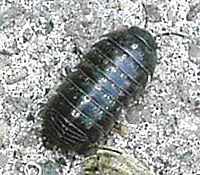Woodlouse
| Woodlice | |
|---|---|

| |
| Armadillidium vulgare | |
| Scientific classification | |
| Kingdom: | |
| Phylum: | |
| Subphylum: | |
| Class: | |
| Order: | |
| Suborder: | Oniscidea |
| Infraorders and Families | |
| |
A woodlouse, also known as a pill bug (genus Armadillidium only), armadillo bug, sow bug, slater, ball bug, potato bug, doodlebug, chuggy pig, roley-poley/roly-poly, butcher boy, daddy gramfer/daddy gampfer (UK, West Country) or cheeselog, is a terrestrial crustacean with a rigid, segmented, calcareous exoskeleton and fourteen jointed limbs. They form the suborder Oniscidea within the order Isopoda, with over 3000 known species. Contrary to their nicknames, they are not insects.
Woodlice need moisture because they breathe through gills and so are usually found in damp, dark places, such as under rocks and logs. They are usually nocturnal and are detritivores, feeding mostly on dead plant matter, although they can be a destructive pest in the garden.
In the United Kingdom there are 37 native or naturalised species ranging in colour and in size (3-30 mm) of which only five are common: Oniscus asellus (the common shiny woodlouse), Porcellio scaber (the common rough woodlouse), Philoscia muscorum (the common striped woodlouse), Trichoniscus pusillus (the common pygmy woodlouse) and Armadillidium vulgare (the common pill bug).
They have a shell-like exoskeleton. As the woodlouse grows, it must progressivly shed this shell. The moult takes place in two stages. The back half is lost first, followed two or three days later by the front. Some woodlice are able to roll into a ball-like form when threatened by predators, leaving only their armoured back exposed. It is this ability which explains many of the woodlouse's common names.
A female woodlouse will keep fertilised eggs in a patch on the underside of her body until they hatch into small, pink offspring. The mother then appears to "give birth" to her offspring.
Woodlice in culture and cinema
Tuck and Roll were the woodlouse acrobats who appeared as supporting characters in the Pixar film A Bug's Life. They have been immortalized in a "Tuck and Roll's Drive'Em Buggies" ride in a bug's land at Disney's California Adventure Park. The giant creatures called Ohmu in Hayao Miyazaki's Nausicaä of the Valley of the Wind also resemble woodlice. Giant woodlice (larger even than a giant isopod) are infrequently featured in the webcomic WIGU. The zoid Gustav, while called "insect type" is clearly a woodlouse.
Trivia
Woodlice are used in AP Biology classes (lab 11) to study animal behavior.
See also
- Woodlouse hunter spider
- Giant isopod, the woodlouse's giant aquatic cousin
Gallery
-
Woodlice in tree bark


